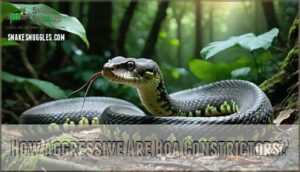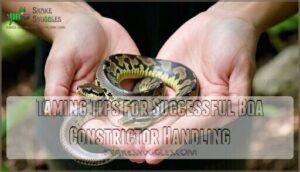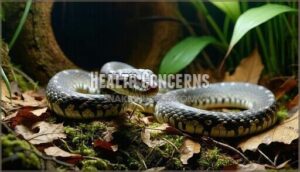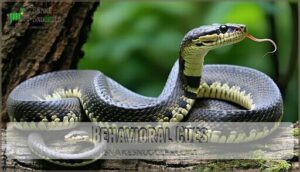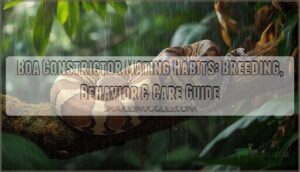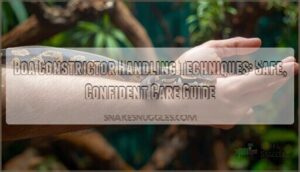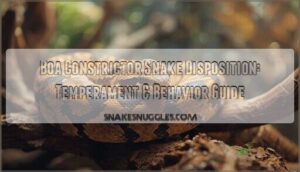This site is supported by our readers. We may earn a commission, at no cost to you, if you purchase through links.
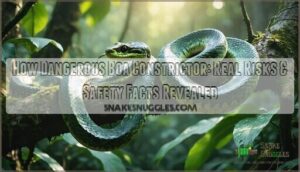
These powerful reptiles pose minimal threat to humans when handled correctly. While they can deliver a painful bite and their muscular coils pack serious strength, documented human fatalities are extremely rare.
Most incidents happen when owners get careless or ignore warning signs like defensive posturing. The key isn’t fear – it’s respect and proper technique.
These docile creatures would rather avoid confrontation than fight. Think of them as living rope with attitude: impressive, demanding respect, but manageable with the right knowledge and safety protocols.
Table Of Contents
- Key Takeaways
- How Dangerous Boa Constrictor?
- Have Boa Constrictors Killed Anyone?
- How Aggressive Are Boa Constrictors?
- Is It Safe to Hold a Boa Constrictor?
- Are Boa Constrictors Friendly to Humans?
- How to Handle a Boa Constrictor
- Do Not Attempt to Handle Your Boa Constrictor If…
- Frequently Asked Questions (FAQs)
- Have boa constrictor killed anyone?
- How aggressive are boa constrictor?
- Is it safe to hold a boa constrictor?
- Are boa constrictors friendly to humans?
- Have boa constrictors ever killed anyone?
- How aggressive are boa constrictors towards humans?
- Is it safe for inexperienced owners to handle boa constrictors?
- When should you not attempt to handle a boa constrictor?
- Can boa constrictors escape from their enclosures easily?
- What size prey do boa constrictors typically hunt?
- Conclusion
Key Takeaways
- You’re statistically safer with a boa than crossing the street – Only two documented deaths from pet boa constrictors have occurred in the U.S., making fatal incidents extraordinarily rare with lifetime odds of 1 in 9.5 million.
- They’re defensive, not aggressive – Boa constrictors don’t attack humans without reason; they’re responding to perceived threats, stress, or mishandling rather than showing genuine hostility toward people.
- Proper handling makes them manageable – You can safely interact with boas by reading their body language, moving slowly, supporting their weight, and avoiding handling during shedding or after feeding.
- Respect their strength and size – While their 25-30 PSI constriction strength won’t kill healthy adults, you shouldn’t underestimate their power, especially around children who can’t handle their size and strength.
How Dangerous Boa Constrictor?
You’re probably wondering if your fascination with boa constrictors comes with serious risks.
The truth is, these snakes pose minimal danger when handled properly.
Only one reported case exists of a pet boa constrictor killing someone in the U.S., making boa constrictor attacks extremely rare.
Boa constrictor danger mainly stems from mishandling rather than inherent aggression.
Their constriction strength reaches about 25-30 PSI – enough to restrain prey but rarely lethal to healthy adults.
Bite severity is typically minor since they’re non-venomous, though snake bite wounds can become infected without proper care.
Risk factors increase with poor handling, stress, or inadequate care.
Child safety requires extra attention since small children can’t handle their size and strength.
Responsible ownership means understanding their behavior, respecting their space, and learning proper techniques.
With knowledge and care, you’ll find these snakes are surprisingly manageable companions.
Have Boa Constrictors Killed Anyone?
Yes, boa constrictors have killed people, but these boa fatalities remain extraordinarily rare.
Death by boa? Incredibly rare—you’re more likely to win the lottery twice.
Only two documented pet boa deaths have occurred in the U.S.: Corey Byrne in 2010, strangled by his 9-foot boa in Nebraska, and Elliot Senseman in 2022, who died from brain injury after his 18-foot snake constricted his neck in Pennsylvania.
The incident involving Elliot Senseman’s death highlights the potential dangers of keeping large constrictors as pets.
These constriction incidents highlight the importance of proper handling, especially regarding child endangerment risks.
Boa attacks account for just 10% of U.S. constrictor-related deaths between 1990-2012, with pythons causing the remaining 90%.
Your lifetime odds of dying from a captive constrictor are 1 in 9.5 million.
All documented cases involved owners or handlers—never bystanders.
Unlike venomous snake bite deaths, boa constrictor attacks cause fatal injuries through circulatory arrest, not venom.
How Aggressive Are Boa Constrictors?
Defensive behaviors define boa constrictor aggression more than true hostility.
Most boa "aggression" is actually fear-based defense—they’re protecting themselves, not hunting you.
You’ll find these snakes rarely attack without reason—they’re responding to perceived threats rather than seeking confrontation.
Their boa temperament remains generally calm, with most snake aggression stemming from specific triggers.
Understanding aggression factors helps prevent dangerous situations:
- Stress responses: Poor handling, inadequate housing, or illness amplify defensive reactions
- Mistaken identity: Food-scented hands trigger feeding responses that seem like snake attacks
- Environmental pressures: Shedding periods and breeding seasons temporarily increase irritability
Handling risks increase when you ignore their warning signs like hissing or defensive posturing.
Bite severity depends on the snake’s size and your response—remaining calm prevents escalation.
Most boa constrictor attacks result from misunderstanding their defensive nature rather than genuine aggression toward humans.
They’re often found in Central and South America.
Is It Safe to Hold a Boa Constrictor?
Holding a boa constrictor can be safe with proper handling safety precautions.
These snakes aren’t typically aggressive, but temperament factors and constriction risks matter.
Experience matters substantially – beginners should seek guidance before attempting contact.
While boa constrictor bites hurt, they’re rarely dangerous.
Boa constrictor attacks are uncommon with calm, respectful snake handling.
Child safety requires constant adult supervision due to size differences.
Practice snake safety by reading your boa’s mood, avoiding handling during shedding or after feeding, and maintaining boa constrictor safety through gentle, confident movements in open spaces.
Their long lifespans require a considerable commitment.
Are Boa Constrictors Friendly to Humans?
Boa constrictors can develop positive relationships with their human handlers, though "friendly" might stretch the definition.
These snakes recognize familiar people and environments, making boa constrictor safety achievable through proper boa socialization.
Their boa temperament tends toward calm and laid-back behavior compared to other large dangerous animals.
Snake safety improves substantially when you understand their predictable nature.
Unlike boa constrictor attacks seen in movies, real interactions are typically peaceful.
Bite severity remains minimal since they’re non-venomous, though their size demands respect.
Child safety requires constant supervision due to strength differences.
Handling frequency affects their comfort level with humans – regular, gentle contact builds familiarity.
Here’s what makes boas manageable companions:
- Intelligence – They remember regular handlers and recognize safe environments
- Predictability – Their body language clearly shows comfort or stress levels
- Adaptability – Captive-bred boas adjust well to human interaction when properly socialized
The boa constrictor threat level stays low with knowledgeable handling and appropriate respect for their natural instincts.
How to Handle a Boa Constrictor
You’ll need proper technique and patience when handling your boa constrictor to guarantee both your safety and the snake’s comfort.
Moving slowly and supporting the snake’s body weight prevents stress-induced defensive behaviors that can lead to bites or unwanted constriction around your arms or neck, which is crucial for maintaining the snake’s comfort.
Taming Tips for Successful Boa Constrictor Handling
Successful boa constrictor handling starts with gradual acclimation—let your snake settle for one week before first contact.
Create a safe environment with proper temperatures and hiding spots.
Begin with short snake handling sessions every few days, using consistent interaction to build trust.
Reading signals like hissing or recoiling helps prevent snake aggression.
Positive reinforcement through calm movements develops effective snake handling techniques and snake safety measures.
Always wash your hands to remove confusing residual scents.
Face Training
Face training through gradual introduction helps your boa recognize that human faces aren’t food sources. This touch desensitization process builds essential safety foundations for handling sessions.
Acclimation techniques for effective face training:
- Start with gentle taps using a snake hook near the head area to signal non-feeding interactions
- Progress slowly to brief hand contact while watching for defensive snake behavior patterns
- Use positive reinforcement by ending sessions when your boa remains calm, building trust over time
This training can be aided using a specialized reptile tool. This safety approach prevents mistaken bite responses and reduces aggression.
What if It Bites??
Getting bitten happens, even with proper face training. Remain calm and hold securely while you gently remove the snake. Don’t yank – this worsens injury.
Clean wound immediately with soap and water for first aid. To guarantee proper hygiene, consider purchasing appropriate cleaning solutions.
Bite severity varies by snake size, but infection risks require attention. Pain management includes over-the-counter medications. Scarring potential depends on wound depth and care.
| Response Step | Action Required |
|---|---|
| Stay calm | Don’t panic or pull away |
| Remove snake | Gently unwind from tail end |
| Clean wound | Use soap and warm water |
| Monitor healing | Watch for infection signs |
| Seek help | Call doctor if severe |
Do Not Attempt to Handle Your Boa Constrictor If…
You shouldn’t handle your boa constrictor when specific health and behavioral warning signs appear, as these conditions can lead to defensive bites or aggressive behavior.
Recognizing these key indicators helps prevent injuries and protects both you and your snake from unnecessary stress during potentially dangerous situations.
Health Concerns
Never handle your boa when health issues arise, as sick snakes pose greater risks to both you and them.
Watch for these warning signs:
- Bacterial Infections – Open wounds, mouth rot, or unusual discharge increase bite severity and salmonella transmission
- Respiratory Issues – Wheezing or mouth breathing indicates stress that triggers defensive behavior
- Shedding Problems – Stuck shed causes irritability and skin reactions
- Obesity Risks – Overweight snakes move unpredictably
Behavioral Cues
Beyond health issues, your boa’s body language tells the complete story.
Watch for defensive posturing like S-shaped coiling with raised head—this means "back off."
Stress signals include loud hissing, rigid body posture, and rapid tongue flicks that differ from normal exploration.
During shedding behavior, their cloudy eyes impair vision, making them jumpy.
If you spot these behavioral cues, postpone handling.
Recognizing these warning signs prevents boa constrictor attacks and keeps everyone safe through proper snake aggression prevention by understanding key signs like defensive posturing and stress signals.
Frequently Asked Questions (FAQs)
Have boa constrictor killed anyone?
Only one documented case exists of a pet boa constrictor killing someone.
You’re statistically safer with a boa than crossing the street.
These snakes rarely attack humans, preferring smaller prey they can actually swallow, and are thus statistically safer to be around.
How aggressive are boa constrictor?
Boa constrictors aren’t naturally aggressive toward humans.
They’re actually quite docile when properly handled and cared for.
You’ll mainly see defensive behavior if they’re stressed, sick, or feel threatened by mishandling.
Is it safe to hold a boa constrictor?
Holding a boa constrictor can be safe if you’re properly trained and follow safety guidelines.
These snakes aren’t naturally aggressive, but they’re strong enough to cause injury through constriction or bites when mishandled.
Are boa constrictors friendly to humans?
Yes, you’ll find boa constrictors are generally friendly and docile toward humans when properly cared for.
They’re intelligent enough to recognize their regular handlers and rarely show aggression unless stressed or mishandled, which makes them docile creatures.
Have boa constrictors ever killed anyone?
Fatal attacks from pet boa constrictors are extremely rare, with only isolated cases reported worldwide.
You’re more likely to face serious injury from improper handling than death, as they typically target smaller prey.
How aggressive are boa constrictors towards humans?
Surprisingly, you’ll find that properly cared-for boas show aggression in less than 5% of handling situations.
They’re generally docile creatures who only become defensive when stressed, sick, or feeling threatened by sudden movements.
Is it safe for inexperienced owners to handle boa constrictors?
No, inexperienced owners shouldn’t handle boa constrictors without proper training.
You’ll need guidance on reading their body language, correct handling techniques, and safety protocols.
Start with experienced mentors before attempting solo interactions with these powerful snakes.
When should you not attempt to handle a boa constrictor?
Don’t handle your boa during shedding, immediately after feeding, or when it’s hissing and coiled tightly.
Avoid handling if you’ve been drinking alcohol or if the snake shows signs of illness or stress.
Can boa constrictors escape from their enclosures easily?
Boa constrictors can escape if you don’t secure their enclosures properly.
They’re surprisingly strong and clever, pushing against loose lids or finding gaps.
Always use secure latches and check for weak spots regularly.
What size prey do boa constrictors typically hunt?
Powerful predators prefer prey proportional to their size.
You’ll find they typically target birds, rodents, and small mammals weighing 10-20 pounds.
Larger specimens can tackle monkeys, wild pigs, and deer up to 60 pounds, which makes them powerful predators in their habitat.
Conclusion
Understanding how dangerous boa constrictor snakes truly are is like learning to read a foreign language – it requires patience and knowledge to decode their signals correctly.
You’ve discovered that these impressive reptiles present minimal risk when handled with proper technique and respect.
Fatal incidents remain exceptionally rare, occurring mainly through careless handling or ignoring warning signs.
By recognizing their body language, maintaining calm confidence, and following safety protocols, you can safely appreciate these remarkable creatures while minimizing potential dangers.
- https://www.battlbox.com/blogs/outdoors/do-boa-snakes-bite-understanding-the-behavior-and-risks-of-boa-constrictors
- https://jamanetwork.com/journals/jamaophthalmology/fullarticle/262853
- https://allaboutboas.com/en/faq/are-boa-constrictors-dangerous-to-humans.html
- https://en.wikipedia.org/wiki/Constriction
- https://www.animalmatchup.com/animal/boa-constrictor


